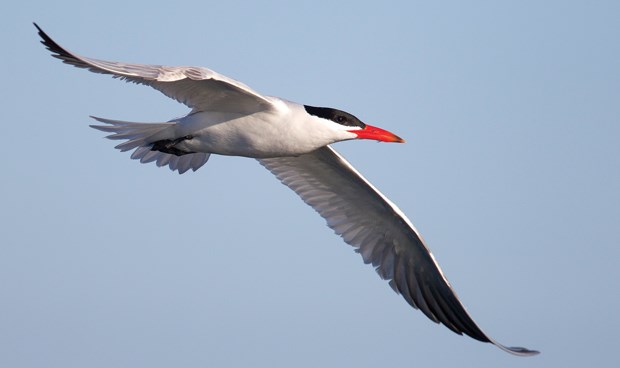Everywhere on the North Shore, nature is showing signs that the seasons are changing.
Wild asters and goldenrods are two of summer's late flowers - a hint that fall is just around the corner.
Birds, too, are getting prepared for fall. All summer long we've enjoyed songs of warblers, vireos, the western tanager, and black-headed grosbeak. Now these species are collecting and getting ready for their long journey south.
Some, like the purple martin, our largest swallow, fly from the North Shore all the way to Brazil for the winter. Others, depending on the species, winter from Mexico through Central and South America. The tiny rufous hummingbird, for example, winters in Mexico. The hummingbirds we see now and through the winter are Annas' hummingbirds.
Sometimes, when weather conditions are right, you can encounter mixed flocks of migrating birds - warblers, vireos, flycatchers and more.
Birders are always thrilled when "fallout" happens at Maplewood Conservation Area. Black-throated gray, orange-crowned, Townsend's and MacGillivray's are typical North Shore warblers to be watched for. And there's always a good possibility in fall migration of spotting a local rarity like the Nashville warbler, or possibly a kingbird.
Raptors are on the move too. Peregrine falcons follow migrating shorebirds from their breeding areas in the North. Turkey vultures pass through the North Shore from breeding areas in British Columbia's Interior in fairly good numbers in fall, although it's not unusual to see vultures throughout the summer.
Southwestern B.C. is a major wintering area for raptors in Canada. Local red-tailed hawk numbers are boosted by migrating wintering birds. Red-tail plumage is highly variable, sometimes leading to identification challenges, because not all red tails have a red tail (like Harlan's type). Our local common "accipiter" or bird hunting hawk is the Cooper's hawk, but watch, too, for sharp shinned, and later in fallwinter, for the Northern goshawk.
Bald Eagles will be heading for salmon streams in areas like Squamish and Harrison Lake and beyond, but there are always eagles to be seen locally.
Always check the sky above you for raptors soaring on thermal air currents. There will sometimes be, mixed species like eagles, red tails, vultures and gulls.
Speaking of gulls and their kin the terns, they're always fun to identify but interestingly, there's no such bird as a "seagull." Recently, at Maplewood Conservation Area for example, ring-billed, California, glaucous-winged and mew gulls were spotted. When winged termites take flight you can sometimes see dainty mew gulls snapping them up in mid-air.
Related to gulls are terns - "swallows of the seas." Locally, both Caspian and common terns should be watched for. Terns dive headlong into the water from high above - it's wonderful to see them do their plunge diving. If you see a large dark bird pursuing terns it could be a jaeger. Jaegers chase terns in order to get them to give up the fish they've caught. A good place to watch for this action is at the pier at Ambleside Park.
It is always a thrill to see flocks of high-flying geese winging their way south, possibly coming from Alaska. These are not our local Canada geese - but the wild ones. It is interesting to note that the Canada goose has been split into two species - the Canada goose and the smaller, darker cackling goose. Two other geese that winter locally are the white-fronted goose and the Brant. Neither one is common on the North Shore, but we have seen them from time to time. (Boundary Bay is where to see brant.)
In the summer, duck species are restricted to a few like the mallard and common merganser. Maplewood Conservation Area is an important sanctuary for waterfowl, and gradually through fall and into the winter waterfowl numbers will guild up. You can expect to see American wigeon, green-winged teal, northern pintail, hooded merganser, scoters, goldeneyes, and bufflehead. With a bit of luck you might even spot a rare Eurasian wigeon.
Loons and grebes that breed on Interior lakes this summer will also arrive to spend the winter in Burrard Inlet. Common loon, redthroated loon, horned grebe are three species to watch for. They will lose their breeding plumage until next spring - in winter we see them in their basic plumage.
Maplewood's tidal flats saw a nice shorebird migration in early August. There was even a sighting of a rare Baird's Sandpiper. Least, western, pectoral, are three examples of commonly seen shorebirds (waders) locally. There are at least 50 wader species on the Vancouver Area checklist.
A spotting scope is almost essential to really appreciate the wonderful world of shorebirds, as well as a good field guide.
There are many wonderful discoveries to be made in the time between late summer and early fall - migrating birds, beautiful butterflies, colourful dragonflies, and dew covered spiderwebs. Enjoy the North Shore's parks and natural areas - keep safe.
Al Grass is a naturalist with Wild Bird Trust of British Columbia, which sponsors free walks at Maplewood Flats Conservation Area on the second Saturday of every month. The next walk will be Saturday, Sept. 14 starting at 10 a.m. - to seek out the first signs of fall. Meet at Maplewood Flats, 2645 Dollarton Hwy. (two kilometres east of the Iron Workers Second Narrows Memorial Crossing). Walks go rain or shine.



